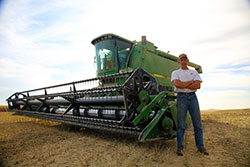|
Solving for 300 bu/A Corn production In Sandy Soils, High In
Nematodes.
In
Irrigated Production previous highest possible yields were 117 Bu./A
on the sandy soil of the Arkansas River flood plain.
-
In
Kansas Conditions, With WSU Mustard Fumigation Process, Seeding U
of Idaho, Pacific Gold.
-
Biological Control, Cyanide Gas Formation Was Achieved.
-
Confirmation of effective suppression using Ag Nema testing.
-
Selection of the correct Pioneer Hybrid Corn helped.
-
Field wide yields increased to 299 bushels per acre.



Biological fumigation in combination with KTS® at 2.1 lbs. S per
gallon and 3 lbs. K per gallon.
Heavy on the sulfur. Avoid the
Chloride.


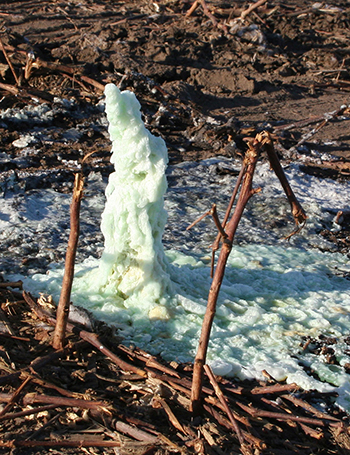
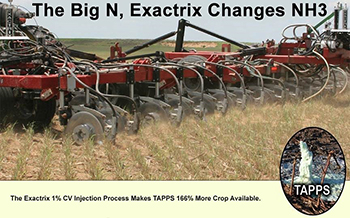

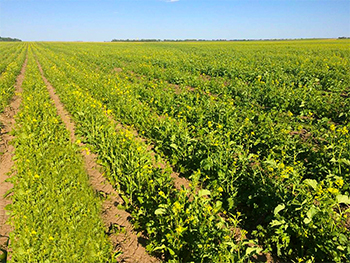

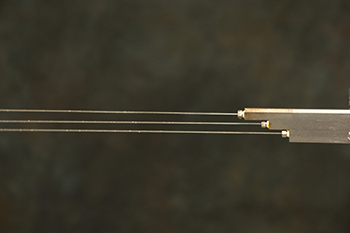 |
 |
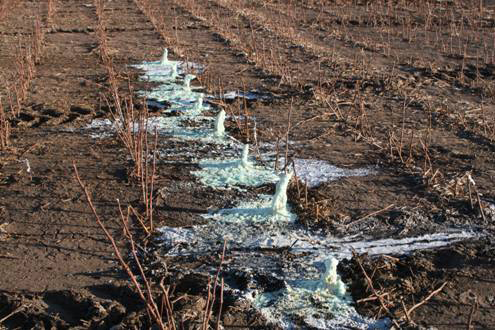 |
Liquid Streaming Flows produce
absolute uniformity. |
TAPPS and TAPPKTS, Corn,
Cotton, Soybean |
Texas Cotton, TAPPS and TAPPKTS |
Binary Banding Moves Ahead With Exactrix P51C and CUE Mustangs
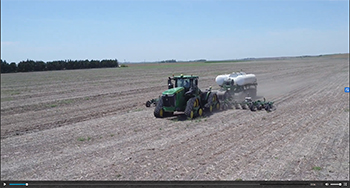
A
video from Shelton, NE, May 2019 In No-tillage Farming.
From The Palouse in Eastern Washington
..
See and Hear Eric Odberg Discussing Variable Rate Application With
Guy Swanson Click For
Video
WSU World Class Face to Face Video Production featuring Eric Odberg
-
Farmer to Farmer Case Study: Precision Nitrogen Application

Eric Odberg

KTS®
review, and investigation. Better than STEEP plots, top notch
financial results.
-
For 2018,
Mark Ricker at Lyons, KS used 15 gallons total of
KTS®….specifications included.
-
He used 5
gallons APP and 10 gallons KTS in the deep band…total 15 gallons
of TAPPKTS.
http://www.cropvitality.com/US/Documents/KTS-Brochure-WEST.pdf
-
In the
planter side band 2 x 2 Mark Ricker used 5 gallons of KTS® on
sandy soils.
-
A total of
15 gallons of KTS® was applied.
-
Nutrients
applied as KTS added up to 31.25 lbs. of S and 45 lbs. of K total
as Potassium Thio-Sulfate.
-
At a cost
of around $3.50 per gallon.
-
In
combination with Pacific Gold Bio-fumigation on nematode infested
sandy soil.
-
The
practice was dramatic as it is in the Columbia Basin potato
production. Fumigant Mustard works with the WSU method included.
-
The sandy
irrigated pivot yields increased about 182 bushels per acre higher
from the starting point of 117 bushels per acre.
-
Yields went
to 299 bushels per acre average.
-
The Mustard
seed cost is $1.00 per lb. and is seeded at 5 lbs. to 7 lbs. per
acre in early March and worked in at bloom about May 15.
-
A 45 to 50
day fumigant crop. The seed is available at two locations in
Kansas.
Mark Ricker.
620 562 7755.
Mark owns 2 Exactrix® TAPPS and TAPPKTS formulators, One on a strip
till tool bar. And one on a Mustang Tool Bar. Lyons, KS is along
the Arkansas River in central Kansas.
Mark also uses
Ag Nema testing to confirm Nematodes for soybean and corn. Ag Nema
is an APHIS approved lab at Pasco, Washington.
https://sites.google.com/view/agnema/home
Mark’s testing also included a confirmation of when the Nematodes
were present for best results of the bio-fumigation. Producers and
their agronomists must connect the dots to determine the timing and
the result. The final result is measured in the yield.
The quantity
of the nematodes must also be determined and the specie. Ag Nema
had developed their laboratory around Potatoes and Alfalfa, Corn is
also a common crop for Ag Nema in rotation with Potatoes. Fungal and
bacterial diseases can also be explored at Ag Nema,
509-255-3744


Too Many Teeth In The
Buzz Saw.
Is it too sandy? Is it Nematodes? Is it Nitrogen? Is it Phosphate?
Is it Potassium? Is it Sulfur? Is it Micro-nutrients?
Previous best was 200 bushels per acre with Fumigation. Using
Pacific Gold Mustard for Fumigation and worked into the soil and 3
gallons KTS 3 gallons ATS and 5 to 7 gallons APP with
micros…..previous best was a dramatic improvement….in fact 5 years
ago when we started at 100 bushel per acre average 5 years ago on
the Arkansas River operating with sandy ground and nematode
problems.
Mark was one of the first to start a Nematode fumigation program
with Mustard for the University of Idaho Breeding Program.
Previous rates were in the 3 gallon range of KTS….so it took 15
gallons per acre to get on top of the problem.
This year Mark took the big leap ahead…. And dropped the ATS in the
band of TAPPKTS and went with 5 gallons APP with 10 gallons KTS.
Then added another 5 gallons KTS side banded.
In
2018, the yield of the pivot averaged 299 bushels per acre with a
120 day Pioneer variety. Strip Tilled with Exactrix TAPPKTS (15
gallons KTS) and mustard fumigation.
He
has tried Potassium Chloride, KCL with Variable Rate and Site
Specific in the range of 150 to 240 lbs. per acre.
The
KCL treatment averaged 150 bushels per acre.
The
soils are sandy for sure.

Triplex Injection. Exactrix developed for three products.
A Shield Ag, Strip Till Opener in Triplex Delivery is utilized by
Mark Ricker.
A Nitro Master 60 foot 24 row tool bar has been selected for 2019.
The combination of Strip Till banding deep TAPPKTS using root
pattern geometry in combination with 2 x 2 at 5 gallons of KTS
produced a general increase of 100 bushels per acre in 2018 harvest.
KCL
is not crop effective at Lyons, KS. Nor in most Nebraska conditions.
The chloride could actually be toxic in heavy applications. High
surface application rates of Sulfate of Potash maybe as high as
1,200 lbs. per acre would need to be top dress applied to compete
with 15 gallons of KTS.
And
in fact uniformity of application allows Variable Site Specific to
work at maximum efficiency when application is made at a 1% CV of
application in 7 to 8 inch deep bands….and TAPPKTS is always
available for future crops in No-till farming. Commonly referred to
as Rotational Band Loading.
At
Lyons, along the Arkansas River, The 240 pound per acre KCL top
dressed in combination with Mustard Fumigation, Pacific Gold, never
took yields much above 150 bushels per acre with mustard fumigation
and TAPPS.
The
utilization of KTS with Mustard Fumigation was and has been powerful
at Lyons, KS.
You have never seen an Exactrix owner work so hard to
get yields up like Mark Ricker on this sandy soil. Mark has
protected land values and approached the solution that is to 100
times more economical than other approaches.
Mark is ready to set another record for this pivot. He is ready to
go again in 2019, Corn on Corn, at Lyons, KS.

Potassium Thiosulfate in TAPPKTS.
0-0-25-17S
Developed by outstanding chemists and scientists of TKI and the
Original Inventors of KTS®.
Superior support form Exactrix teamed with original builders of KTS
builds a bigger margin.
Clearly Superior Potassium Fertilizer.
Note: Applications to 5 degrees Fahrenheit are possible with KTS, An
ideal product in Northern climates and an ideal material to blend
with 10-34-0.
Corn Gets
Biological Yield Enhancement
Suppressing Nematodes in Sandy Soil; Fumigation Biologically
Applied.
Pacific Gold Mustard is fumigant grade. The University of Idaho,
PPV mustard plant, is high in Glucosinolate content forming ally
isothiocyanate in the soil.
The plant is dual purpose. Pacific Gold is bred as an oriental
mustard for export and used in cooking oils with a pungent taste.
Pacific Gold is also bred as a fumigant grade mustard and used for
cleaning up problematic soils.
Soil fumigation can be effective with certain types of mustards. The
target must be identified. In this case, the target is nematodes.
The strip till pass was made 2 weeks earlier with no nutrients
applied, since soybean will be produced.
This is an Arkansas River floodplain as a sandy soil type with
nematode infestation. The problem has been identified as root lesion
nematode and soybean cyst nematode.

Bigger plants
observed….Making an applied nitrogen test.
The larger mustard plants on the right side of the picture were
fertilized at an
angle
with a P-51 Mustang Tool bar. The mustard leaves were about 2.5
times larger with only NH3 applied. There was no ATS or KTS applied
in the test. KCL was top dressed at 150 to 240 pounds per acre in
this 2015 example or 150 pounds of K and 96 pounds of Chloride.
Lyons, KS,
May
11,
2015
Mark Ricker, Exactrix® owner planted soybeans and corn into the
Pacific Gold Mustard, May 11, 15. Mark
Ricker carried out No till Mustard Fumigation and testing at Lyons
in 2014, with good results in full pivot size plots.
In
fact, Pacific Gold testing in 2014 showed giant increases in corn
production. The test plots were not official or by STEEP standards.
2014 was a No-till fumigation program. 2015 was a strip till program
in March 1 seeded Pacific Gold Mustard. TAPPKTS Banding of nutrients
were 15 inch in 2014 and 30 inch in 2015.
 3
3  4 4
Mark Ricker’s P-51,
Exactrix® Mustang Tool Bar was utilized to no-tillage band TAPPS and
TAPPKTS.
The Exactrix fertilized Pacific Gold fumigant grade mustard plants
were taller plants and much healthier with 55 lbs./A of NH3
applied.
There was likely a double in the bio-mass so fertilizer application
to fumigant mustard will work economically.
The conclusion for next year is about 30 pounds N/A and about 30
lbs./A, Ammonium Thio-Sulfate, Thio-Sul®, to be applied when Pacific
Gold fumigant grade mustard is included in the rotation with
Soybeans.
Sulfur application is important to improve Glucosinolate production
along with nitrogen to make amino acids. TAPPS and TAPPKS
application can also be considered.
The fumigant crop can also be irrigated to improve the stands. Seed
cost is about $1.00 per lb. The crop is normally seeded at 5 lbs.
per acre. The water cost can be as high as $10.00 per acre. The
nutrient cost should be around $20 to $30 per acre using NH3 and
Thio-sul®. Costs of $5.00 to as high $55.00 per acre are considered
acceptable, since the results from last year showed an additional
$400 to $500 per acre of income. Gigantic yield increases were
observed due to suppression of nematodes using Pacific Gold Mustard.

The
Glucosinolate molecule breaks down with water to form ally
isothiocyanate. The result is a natural, rotational control or
suppression of nematodes with no significant damage to earthworm
populations.
The 30 inch
strips will be planted to soybeans by May 12,
15.
The Pacific
Gold mustard and RR soybeans will be applied with Roundup® in about
2 weeks after the Pacific Gold mustard is fully bolted. Soybeans
are more light sensitive than corn from the competitive effect.
In 2014 the
No-tillage Pacific Gold fumigant mustard produced a very significant
yield boost in corn production. The full pivot test produced a very
big jump in yield as compared to previous corn crops.
Lost Yield
Potential.
The pivot tested has consistently lost or declined in yield from
1996 in a corn soybean rotation. The previous corn crop had yielded
only 117 bushels per acre due to nematodes. Crop Quest consultant,
Jon French has been doing the testing for nematodes.
Using
March seeded Pacific Gold Fumigant Mustard,
the nematode population can be reduced for the following corn crop
in 2016.
In fact,
the nematode problem is so significant that every opportunity must
be made to fumigate starting in March, or even if the crop is hailed
out. Pacific Gold Mustard will work very well on hailed out pivots.
The Pacific
Gold mustard was planted about March 3,
2015 at 10 lbs.
The field
was strip tilled in late April in preparation for corn or soybean,
in this case soybean.
Some strip
tilled fields are also prepared for corn and Exactrix TAPPS and
TAPPKTS nutrients are placed directly below the seed rows.
May 6,
2015 at Lyons, KS, Exactrix TAPPS and TAPPKTS, strip till corn in
Pacific Gold mustard fumigated soils.

Strip
Till into growing Mustard in 2015
This technique did not
work well.
In 2016 to 2018 a change
to the WSU technique of Fumigant Mustard using field choppers and
light tillage to work the mustard into the soil.
The WSU technique was
confirmed successful and remains in place today.
Learn
how to Fumigate with Pacific Gold Mustard.
https://www.youtube.com/watch?v=z9qYSSqmOd8

Pacific Gold Mustard
Seed is about $1.00 per pound.
Seed rates 1 to 5 pounds
per acre is considered functional.
You can move a mountain
with Pacific Gold mustard.
 7.1
7.1
High Risk
Potatoes Get Mustard In Rotation.
Mustard green manure being chopped and disked in
October in the Columbia Basin.
http://aenews.wsu.edu/June03AENews/June03AENews.htm#GreenManure
Chemistry
Glucosinolates constitute a natural class of
organic compounds
that contain
sulfur
and
nitrogen
and are derived from
glucose
and an
amino acid.
They are water-soluble
anions
and can be leached into the water during cooking.[
Glucosinolates belong to the
glucosides.
Every glucosinolate contains a central
carbon
atom, which is bound via a sulfur atom to the thioglucose group
(making a sulfated
aldoxime)
and via a nitrogen atom to a sulfate group. In addition, the central
carbon is bound to a side group; different glucosinolates have
different side groups, and it is variation in the side group that is
responsible for the variation in the biological activities of these
plant compounds. Some glucosinolates:
|
EXACTRIX, Rated in the top ten agricultural websites in North
America.
For
producers who want to learn more about increasing
crop production, we provide some good answers in the
Exactrix
library.
EXACTRIX GLOBAL SYSTEMS makes the news
See
Video
|
EXACTRIX LINKS
·
Meeting your formulation
needs.
www.exactrix.com/TF.htm
·
Need more information on
advanced crop production.
www.exactrix.com/EWAC.htm
·
Picking your metering
systems.
www.exactrix.com/EPM.htm
·
Click HERE
to read more about the
Deere Exactrix Wing Injection System

Swiveling Single Disc P-51 openers. Closing Wheels not required on
15 inch band spacing.
On 30 inch spacing in tillage systems closing wheels can be used.
 9
9
Fertilizing Winter
Wheat with Exactrix TAPPS in Marshall, MO area. A powerful means
to conserve.
 10
10
Smith Center, KS. Fertilizing Winter Wheat in early April. Big jump
in economics…much higher yields.
http://www.youtube.com/watch?v=T5botwQL49I&fmt=37
http://www.youtube.com/watch?v=OK6UVA5gLSI
http://www.youtube.com/watch?v=LIooFXM398k
 |
 |
 |
|
Start Ski Season Early in North Dakota |
USDA-ARS, Single Disc Tool Bar at Walla Walla.
|
Schmit Brothers, Osmond, Neb |

Your Great Plains Reporter.

Guy Swanson.

Plant Beans on Top of the Binary
Band of TAPPKTS and Ferrilene®
Dramatic Results on soil pH to
7.5 to 9 pH.
Ferrilene works every time with
Exactrix Binary Banding of Soybeans with TAPPKTS.
Check out all our broadcasts..Click
Here
Contact
Exactrix Global Systems.
509-995-1879 or
509-254-6854
e-mail:exactrix@exactrix.com
|






















 4
4













